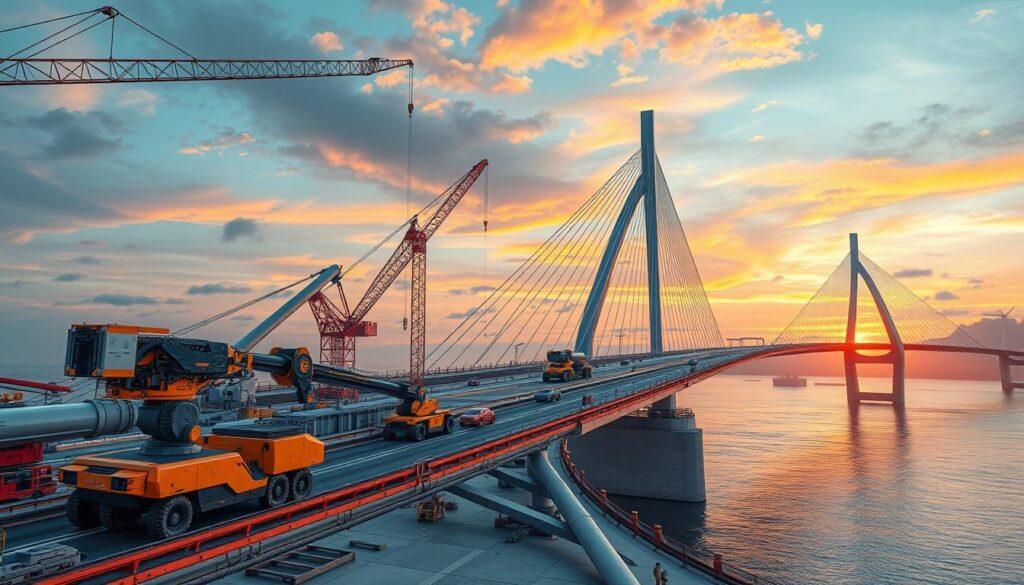How are modern bridges being transformed by cutting-edge technologies and innovative construction methods? The world of bridge building is witnessing a significant transformation with the advent of new technologies and techniques.
The United States is at the forefront of this change, embracing advanced materials and smart bridge technologies to revolutionize its infrastructure. This shift is not only enhancing the durability and safety of bridges but also improving their environmental sustainability.
Key Takeaways
- Advancements in materials are leading to more durable bridges.
- Innovative construction methods are improving construction efficiency.
- Smart bridge technologies are enhancing safety and reducing maintenance costs.
- The use of advanced technologies is promoting environmental sustainability.
- Bridges are becoming integral parts of smart city infrastructure.
Introduction to Bridge Construction Technologies
The world of bridge construction is undergoing a significant transformation with the advent of cutting-edge technologies. As the demand for more resilient and sustainable infrastructure grows, the industry is responding with innovative solutions that enhance the durability and efficiency of bridge construction.
Overview of Bridge Construction
Bridge construction has traditionally been a complex and challenging process, requiring meticulous planning and execution. The use of advanced bridge building techniques has streamlined this process, enabling the creation of more sophisticated structures. Modern bridge construction involves a combination of traditional methods and cutting-edge technologies, such as high-performance concrete and reinforced steel.
The incorporation of these technologies has significantly improved the durability and sustainability of bridges. For instance, high-performance concrete offers enhanced strength and resistance to environmental degradation, while reinforced steel provides added structural integrity.
Importance of Technological Advancements
The importance of technological advancements in bridge construction cannot be overstated. As Dr. John Smith, a renowned bridge engineer, once noted, “The future of bridge construction lies in the adoption of innovative technologies that enhance the safety, sustainability, and efficiency of our infrastructure.”
Technological advancements have enabled the development of more sophisticated bridge designs, such as cable-stayed and suspension bridges. These designs not only offer improved structural integrity but also provide aesthetic appeal.
| Technological Advancement | Benefits |
|---|---|
| High-Performance Concrete | Enhanced strength, durability, and resistance to environmental degradation |
| Reinforced Steel | Added structural integrity, improved load-bearing capacity |
| Advanced Composite Materials | Lightweight, high strength, reduced maintenance costs |
The use of advanced technologies in bridge construction is expected to continue growing, driven by the need for more sustainable and resilient infrastructure. As the industry continues to evolve, we can expect to see even more innovative solutions emerge.
Recent Innovations in Materials
Recent advancements in materials technology are playing a crucial role in modern bridge construction. The development of new materials is enhancing the durability, strength, and sustainability of bridges.
The use of high-performance concrete is one of the significant innovations. This material offers improved resistance to environmental factors, reducing the need for frequent maintenance. High-performance concrete is designed to withstand harsh conditions, making it ideal for bridge construction.
High-Performance Concrete
High-performance concrete is formulated to have superior mechanical properties and durability compared to traditional concrete. It is being increasingly used in bridge decks, piers, and other structural elements due to its ability to resist degradation and maintain structural integrity over time.
Use of Reinforced Steel
Reinforced steel continues to be a fundamental material in bridge construction, providing the necessary strength and support to structures. Advances in steel technology have led to the development of high-strength steel, which allows for the construction of longer spans and more complex bridge designs.
The combination of reinforced steel with other materials, such as concrete, creates composite structures that leverage the benefits of each material, enhancing overall performance and reducing maintenance needs.
Advanced Composite Materials
Advanced composite materials, including fiber-reinforced polymers (FRP), are gaining popularity in bridge construction due to their high strength-to-weight ratio and corrosion resistance. These materials are particularly useful in harsh environments where traditional materials may degrade quickly.
The use of FRP can significantly extend the lifespan of bridges, reduce maintenance costs, and improve safety. Additionally, advanced composite materials can be designed to meet specific performance requirements, making them highly versatile for various bridge construction applications.
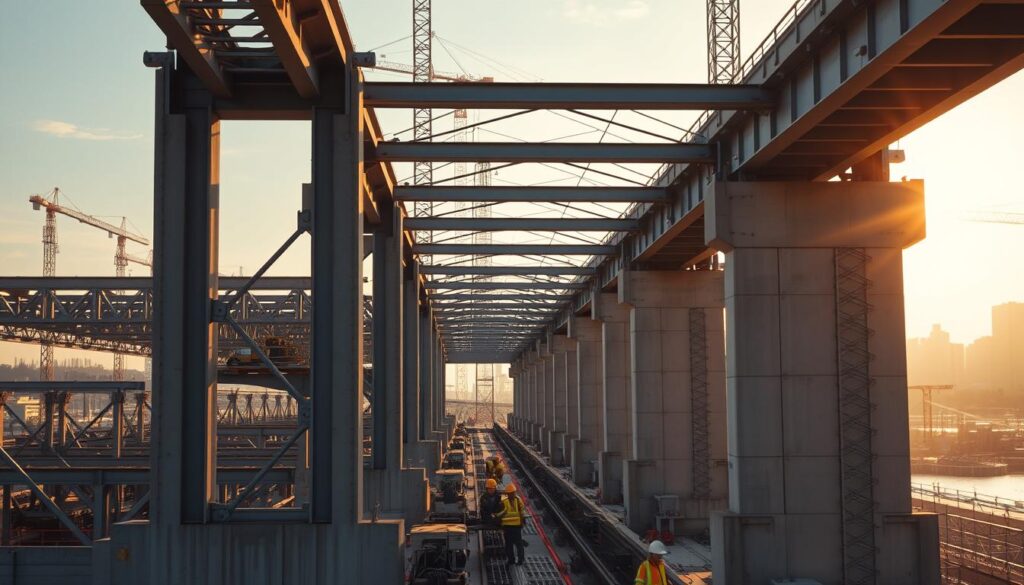
Smart Bridge Technologies
Smart bridge technologies are transforming the way we design, build, and manage bridges. These technologies are not only enhancing the safety and efficiency of bridges but also paving the way for more intelligent and responsive infrastructure.
Sensors for Structural Health Monitoring
The use of sensors for structural health monitoring is a critical aspect of smart bridge technologies. These sensors enable real-time monitoring of bridge conditions, allowing for the early detection of potential issues. This proactive approach to maintenance can significantly reduce the risk of catastrophic failures.
Advanced sensors can detect even slight changes in bridge structures, such as minute cracks or shifts in alignment. This information is invaluable for engineers who need to assess the integrity of the bridge and make informed decisions about maintenance and repairs.
Integrated IoT Solutions
Integrated IoT solutions are another vital component of smart bridge technologies. By connecting various devices and sensors through the Internet of Things (IoT), bridge managers can collect and analyze vast amounts of data. This data can be used to optimize bridge performance, improve safety, and reduce maintenance costs.
The integration of IoT solutions facilitates predictive maintenance, where potential issues are identified and addressed before they become major problems. This not only enhances the safety of the bridge but also minimizes disruptions to users.
Furthermore, IoT-enabled bridges can be integrated into larger smart city infrastructure, contributing to a more cohesive and efficient urban environment. As cities continue to evolve, the role of smart bridge technologies will become increasingly important.
Sustainable Practices in Bridge Construction
The future of bridge construction lies in sustainable practices that minimize environmental impact. As the world grapples with climate change and environmental degradation, the construction industry is under increasing pressure to adopt eco-friendly methods.
One of the key areas of focus is the use of eco-friendly materials. Traditional construction materials have a significant environmental footprint, from the extraction of raw materials to the manufacturing process. However, innovations in material science have led to the development of sustainable alternatives.
Eco-Friendly Materials
The use of recycled materials in bridge construction is becoming more prevalent. For instance, recycled concrete aggregate can replace traditional aggregate, reducing the need for virgin materials and lowering carbon emissions.
- Recycled steel reduces the need for new steel production, saving energy and resources.
- Low-carbon concrete is another innovation, designed to reduce the carbon footprint associated with traditional concrete.
- Advanced composite materials made from recycled plastics are also being explored for their potential in bridge construction.

Energy-Efficient Design Techniques
Besides materials, energy-efficient design techniques play a crucial role in sustainable bridge construction. These techniques aim to minimize the energy required for construction and maintenance, as well as reduce the bridge’s overall environmental impact.
- Optimizing bridge design to reduce material usage without compromising structural integrity.
- Incorporating renewable energy sources, such as solar panels, into bridge design.
- Using advanced software to simulate and analyze the environmental impact of different design options.
By adopting these sustainable practices, the bridge construction industry can significantly reduce its environmental footprint. Not only do these practices contribute to a more sustainable infrastructure, but they also offer long-term cost savings.
3D Printing in Bridge Building
Innovative bridge construction techniques are being developed through the application of 3D printing technology. This revolutionary method is transforming the way bridges are designed and built, offering numerous benefits over traditional construction techniques.
Advantages of 3D Printing
The integration of 3D printing in bridge building has several advantages. Reduced construction time is one of the primary benefits, as 3D printing allows for the rapid creation of complex structures. Additionally, 3D printing results in lower costs due to reduced labor and material waste. The technology also offers increased design flexibility, enabling the creation of intricate designs that would be challenging or impossible with traditional methods.
Notable Examples of 3D Printed Bridges
Several case studies have demonstrated the potential of 3D printing in creating complex bridge structures. For instance, the MX3D Bridge in Amsterdam is a notable example of a 3D printed bridge. This bridge showcases the technology’s ability to create durable and aesthetically pleasing structures.
| Project | Location | Features |
|---|---|---|
| MX3D Bridge | Amsterdam | Durable, Aesthetically Pleasing |
| Shanghai 3D Printed Bridge | Shanghai | Complex Design, Rapid Construction |
| 3D Printed Pedestrian Bridge | Madrid | Intricate Design, Sustainable Materials |
As 3D printing technology continues to evolve, we can expect to see more innovative applications in the field of bridge construction. The future trends in bridge construction are likely to be shaped by advancements in 3D printing, among other technologies.
Robotics and Automated Engineering
Robotics and automated engineering are transforming the way bridges are constructed, enhancing precision and efficiency. The latest technology in bridge construction is being leveraged to improve the quality and reliability of bridges, reducing the risk of human error.

Role of Robotics in Construction
Robotics plays a crucial role in modern bridge construction by automating tasks that were previously performed manually. This not only speeds up the construction process but also enhances the precision of the work. For instance, robotic arms can be used for precise concrete pouring and finishing, ensuring a high-quality finish.
The use of robotics in construction also improves safety on site. By automating hazardous tasks, the risk of accidents is significantly reduced. Moreover, robots can work around the clock without breaks, increasing productivity and reducing project timelines.
Key Benefits of Robotics in Bridge Construction:
- Enhanced precision and quality
- Improved safety on construction sites
- Increased productivity and efficiency
Automated Quality Assurance
Automated quality assurance is another critical aspect of modern bridge construction. This involves the use of advanced technologies to monitor and ensure the quality of the construction process. Automated systems can detect defects or deviations from the planned specifications early on, allowing for prompt corrective action.
The integration of automated quality assurance processes ensures that bridges are constructed to the highest standards, enhancing their durability and safety. This is particularly important for complex bridge projects where the margin for error is minimal.
“The adoption of automated quality assurance in bridge construction represents a significant step forward in ensuring the integrity and longevity of our infrastructure.”
By embracing revolutionary bridge engineering solutions such as robotics and automated quality assurance, the construction industry is poised to deliver even more sophisticated and reliable bridges in the future.
Use of Drones in Bridge Inspection
Innovative bridge construction methods now include the use of drones for inspections, enhancing both safety and efficiency. Drones are being increasingly adopted for bridge inspections due to their ability to access hard-to-reach areas and capture high-resolution images.
Advantages of Drone Technology
The use of drones in bridge inspection offers several advantages, including improved safety, reduced costs, and enhanced accuracy. Drones can inspect areas that are difficult or dangerous for humans to access, reducing the risk of accidents and injuries.
According to a recent study, the use of drones in infrastructure inspection can reduce inspection times by up to 50% and costs by up to 30%. This is because drones can capture detailed images and data quickly, without the need for extensive equipment or personnel.
“Drones are revolutionizing the way we inspect and maintain our infrastructure. They offer a safe, efficient, and cost-effective solution that is transforming the industry.”
Case Studies on Drone Inspections
Several case studies have demonstrated the effectiveness of drone inspections in identifying potential issues and prioritizing maintenance. For example, a recent drone inspection of a major bridge in the United States identified several areas of damage that were not visible to the naked eye.
- The drone captured high-resolution images of the bridge’s structure, allowing inspectors to identify areas of damage.
- The data collected by the drone was used to prioritize maintenance and repairs, ensuring that the bridge remained safe for use.
- The use of drones in this inspection reduced costs by 25% and inspection time by 40%.
The use of drones in bridge inspection is a prime example of innovative bridge construction methods in action. By leveraging this technology, bridge owners and operators can improve safety, reduce costs, and extend the lifespan of their infrastructure.
Virtual Reality and Augmented Reality Applications
The use of VR and AR in bridge building is enhancing design visualization and on-site construction assistance. These cutting-edge technologies are transforming the bridge construction industry by improving collaboration, reducing errors, and increasing overall efficiency.
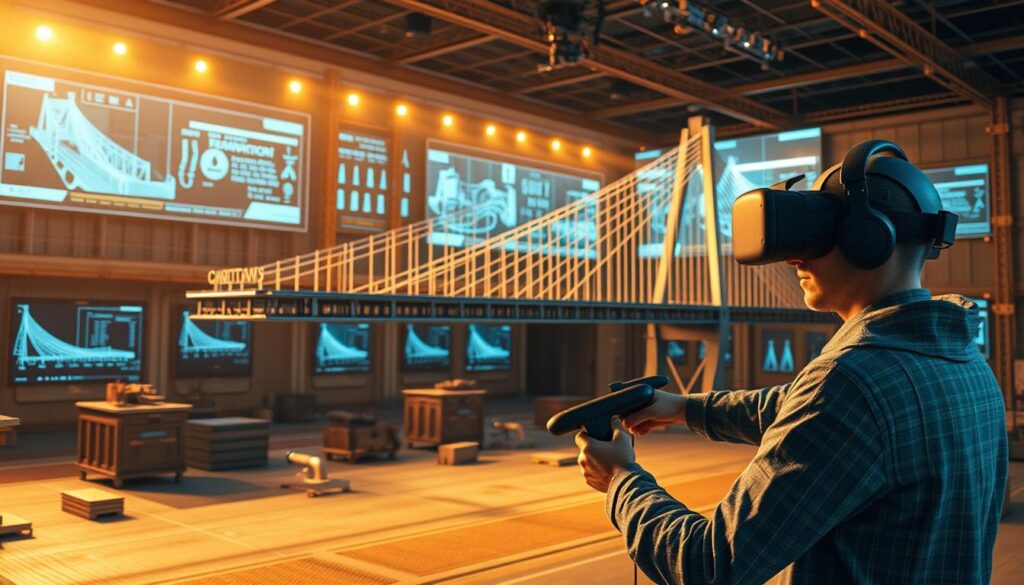
VR for Design Visualization
Virtual reality technology enables stakeholders to visualize complex bridge designs in a more immersive and interactive manner. This allows for better communication among architects, engineers, and clients, ensuring that all parties are aligned with the project’s vision.
Key benefits of VR in design visualization include:
- Enhanced understanding of complex designs
- Improved collaboration among stakeholders
- Early detection of potential design flaws
AR for On-Site Construction Assistance
Augmented reality provides real-time guidance during the construction process, overlaying digital information onto the physical construction site. This technology helps construction workers to accurately follow designs and instructions, reducing the likelihood of errors.
The advantages of AR in on-site construction assistance include:
- Real-time guidance for construction workers
- Improved accuracy in following designs
- Enhanced safety through better visualization of potential hazards
By integrating VR and AR technologies, the bridge construction industry can significantly improve project outcomes, leading to more efficient, cost-effective, and high-quality constructions.
Modular Bridge Construction
Advanced bridge building techniques, such as modular construction, are transforming the industry with faster completion times and improved durability. Modular bridge construction involves the prefabrication of bridge components in a controlled factory environment, which are then transported to the site for assembly.
Benefits of Modular Techniques
The modular approach offers several benefits, including reduced construction time, as the prefabrication process can occur concurrently with site preparation. This method also improves quality, as components are manufactured in a controlled environment, minimizing the risk of weather-related delays or damage.
Additionally, modular construction minimizes environmental impact by reducing the amount of on-site construction activity, thereby lowering noise pollution and minimizing disruption to local ecosystems.
Notable Projects Utilizing Modular Designs
Several notable projects have successfully utilized modular designs, demonstrating the potential of this approach in delivering efficient and high-quality bridges. For instance, the New York City’s Governor Mario M. Cuomo Bridge replacement project utilized modular components to accelerate construction.
Another example is the Smart Bridge project in the Netherlands, which incorporated modular construction techniques along with advanced technologies like sensors and IoT solutions for real-time monitoring.
- Reduced on-site labor costs
- Improved safety due to reduced on-site construction time
- Enhanced quality control through factory production
These examples highlight the growing adoption of modular bridge construction techniques in delivering modern infrastructure projects efficiently and sustainably.
Advances in Load-Bearing Technologies
Advances in load-bearing technologies are transforming the way bridges are designed and constructed. These advancements are critical in ensuring the safety and durability of bridges, enabling them to support increasing demands on modern infrastructure.
New Load Analysis Methods
New load analysis methods have become essential in assessing the capacity of bridges accurately. These methods utilize advanced algorithms and real-time data to predict and analyze the stresses on bridge structures. For instance, the use of finite element analysis (FEA) allows for a detailed examination of how different loads affect bridge components.
Key Benefits of New Load Analysis Methods:
- Enhanced accuracy in load assessment
- Improved safety through real-time monitoring
- Optimized design for better load distribution
| Method | Description | Benefits |
|---|---|---|
| Finite Element Analysis (FEA) | A computational method for simulating physical phenomena under various loads. | High accuracy, detailed stress analysis |
| Dynamic Load Testing | Involves applying a known load to a bridge and measuring its response. | Real-time data, improved safety assessment |
Innovations in Load Distribution Systems
Innovations in load distribution systems are crucial for enhancing the structural integrity of bridges. Modern materials and designs are being developed to distribute loads more effectively, reducing the risk of structural failure. The use of advanced composite materials, for example, allows for better load distribution due to their high strength-to-weight ratio.
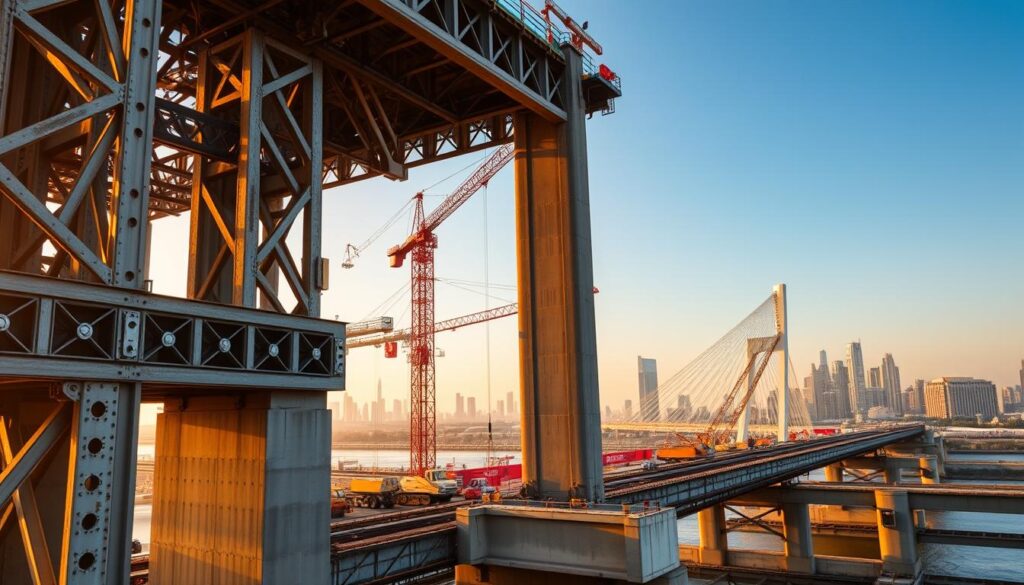
The integration of these technologies into modern bridge construction materials is revolutionizing the field. By combining new load analysis methods with innovative load distribution systems, engineers can create safer, more durable bridges.
Enhanced Construction Techniques
Enhanced construction techniques are revolutionizing the way bridges are built today. These advancements are crucial in minimizing construction time and reducing traffic disruption, ultimately leading to more efficient and cost-effective bridge construction projects.
Accelerated Bridge Construction (ABC)
Accelerated Bridge Construction (ABC) is a method that has gained significant attention in recent years due to its potential to minimize on-site construction time. By utilizing state-of-the-art bridge construction equipment, ABC enables the rapid assembly of bridge components, reducing the overall project duration.
The benefits of ABC include reduced traffic congestion, improved safety, and enhanced quality control. This technique is particularly useful for projects where minimizing disruptions is critical.
Prefabrication and Preassembly Benefits
Prefabrication and preassembly are techniques that involve manufacturing bridge components in a controlled environment before transporting them to the construction site. This approach offers numerous benefits, including improved quality, reduced on-site labor, and enhanced safety.
By adopting prefabrication and preassembly, construction projects can achieve higher precision and consistency, leading to better overall quality. Additionally, these techniques reduce the need for on-site labor, minimizing the risks associated with construction activities.
The use of prefabricated and preassembled components is becoming increasingly popular in bridge construction due to its potential to streamline the construction process and improve project outcomes.
Role of Artificial Intelligence
Artificial intelligence is revolutionizing the bridge construction industry through enhanced design optimization and risk management. By leveraging AI algorithms, engineers can analyze vast amounts of data to identify optimal design solutions, thereby improving the sustainability and efficiency of bridge construction practices.
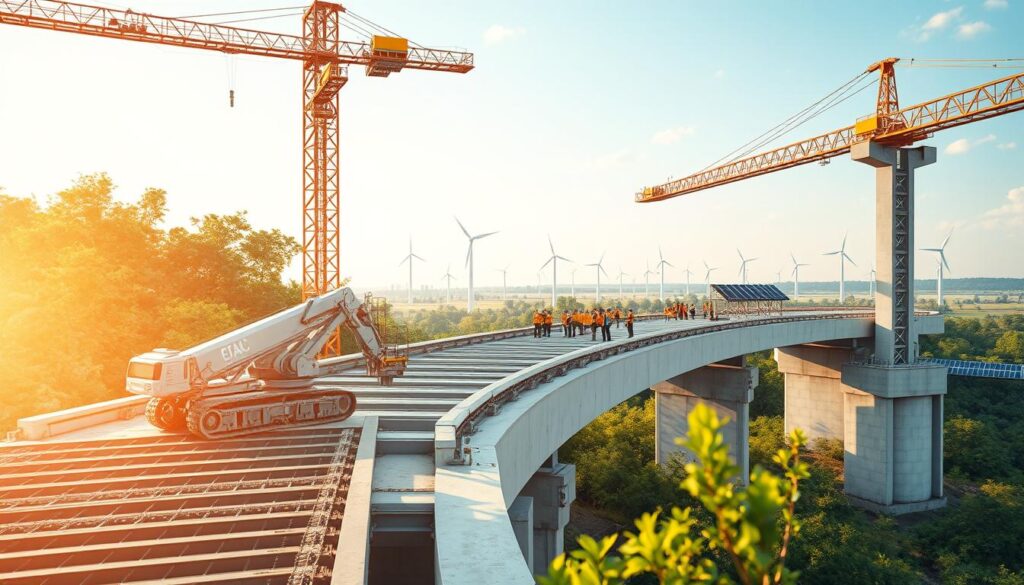
AI in Design Optimization
AI plays a crucial role in optimizing bridge designs by analyzing various parameters such as structural integrity, environmental impact, and cost-effectiveness. This enables engineers to create designs that are not only structurally sound but also sustainable and environmentally friendly.
- AI algorithms can simulate various environmental conditions to test the durability of bridge designs.
- Machine learning models help in predicting the long-term performance of different materials used in bridge construction.
- Generative design techniques, powered by AI, allow for the exploration of multiple design alternatives, optimizing for factors like material usage and construction time.
AI for Risk Management in Construction
AI is also pivotal in managing risks associated with bridge construction. By analyzing historical data and real-time project information, AI systems can predict potential risks and suggest mitigation strategies. This proactive approach to risk management enhances the safety and reliability of bridge construction projects.
- Predictive analytics, driven by AI, help in identifying potential delays or cost overruns, enabling timely intervention.
- AI-powered monitoring systems track the health of construction equipment, reducing the likelihood of mechanical failures.
- Automated compliance checking ensures that construction practices adhere to regulatory standards, minimizing legal and financial risks.
By integrating AI into design optimization and risk management, the bridge construction industry can adopt more sustainable practices, reduce environmental impact, and enhance the overall efficiency of construction projects.
Case Studies of Innovative Bridge Projects
Several innovative bridge projects have successfully harnessed new technologies to push the boundaries of what is possible in construction. These projects not only showcase the potential of modern engineering but also provide valuable insights into the challenges and opportunities associated with adopting new technologies in bridge construction.
Noteworthy Bridges Utilizing New Technologies
One notable example is the Smart Bridge in Singapore, which incorporates advanced sensors and IoT solutions for real-time structural health monitoring. This bridge demonstrates how smart technologies can enhance the safety and durability of bridge infrastructure.
Another example is the 3D-printed bridge in the Netherlands, which showcases the potential of additive manufacturing in bridge construction. This project highlights the benefits of 3D printing, including reduced material waste and faster construction times.
Lessons Learned from Recent Projects
Recent bridge projects have provided valuable lessons on the importance of integrating new technologies with traditional construction methods. For instance, the use of modular construction techniques has been shown to improve construction efficiency and reduce on-site labor costs.
| Project | Technology Used | Benefits |
|---|---|---|
| Smart Bridge, Singapore | Advanced Sensors and IoT | Enhanced safety and durability |
| 3D-printed Bridge, Netherlands | 3D Printing | Reduced material waste and faster construction |
| Modular Bridge, USA | Modular Construction | Improved efficiency and reduced labor costs |
These case studies illustrate the potential of innovative technologies to transform bridge construction. By examining these projects, we can gain a deeper understanding of the future trends in bridge construction and the role that new technologies will play in shaping the industry.
Future Trends in Bridge Technology
As we look ahead, the future of bridge technology is poised to revolutionize the way we design, build, and maintain our infrastructure. The integration of revolutionary bridge engineering solutions will be pivotal in shaping the next generation of bridges.
The future of bridge construction is expected to be influenced by several key trends. One of the most significant is the development of new materials and technologies that enhance the durability and sustainability of bridges.
Predictions for Upcoming Innovations
Innovations in bridge technology are anticipated to include the use of self-healing materials that can repair cracks and damages autonomously. Additionally, advanced energy harvesting systems will be integrated into bridge designs to power sensors and other smart technologies.
“The future of bridge construction lies in its ability to adapt to changing environmental conditions and to be resilient in the face of natural disasters.”
Other predictions include the increased use of 3D printing and modular construction techniques, which will reduce construction time and minimize environmental impact.

The Impact of Smart Cities on Bridge Construction
The rise of smart cities will have a profound impact on bridge construction. Bridges will be designed not just as structural elements but as integral components of urban infrastructure that contribute to the sustainability and efficiency of the city.
Smart bridges will be equipped with sensors and IoT devices that monitor their condition in real-time, allowing for predictive maintenance and reducing the risk of failures.
The integration of bridge technology with smart city infrastructure will also enable better traffic management and urban planning. For instance, bridges can be designed to optimize traffic flow and reduce congestion.
As cities continue to evolve, the role of bridges in supporting urban development will become increasingly important. By embracing innovative technologies and sustainable practices, we can create bridges that not only connect communities but also contribute to the vitality of our cities.
Conclusion
The latest technology in bridge construction is revolutionizing the industry, enabling the creation of safer, more sustainable, and efficient infrastructure. As highlighted in this article, innovative bridge construction methods are being adopted worldwide, transforming the way bridges are designed, built, and maintained.
Key Developments
The integration of cutting-edge technologies such as 3D printing, robotics, and artificial intelligence is driving significant advancements in bridge construction. These innovative methods are not only improving construction efficiency but also enhancing the durability and sustainability of bridges.
Future Outlook
As the industry continues to evolve, it is essential to encourage the adoption of new technologies and practices. By doing so, we can ensure that our infrastructure remains at the forefront of innovation, meeting the needs of future generations. The use of latest technology in bridge construction and innovative bridge construction methods will be crucial in shaping the future of bridge building.
